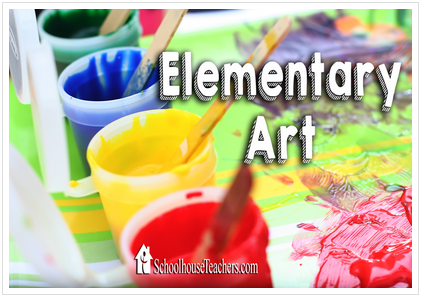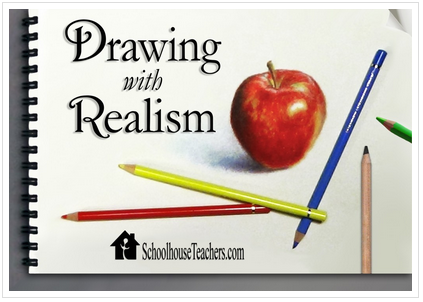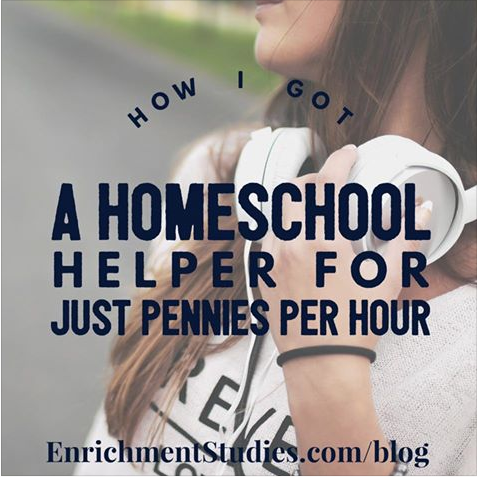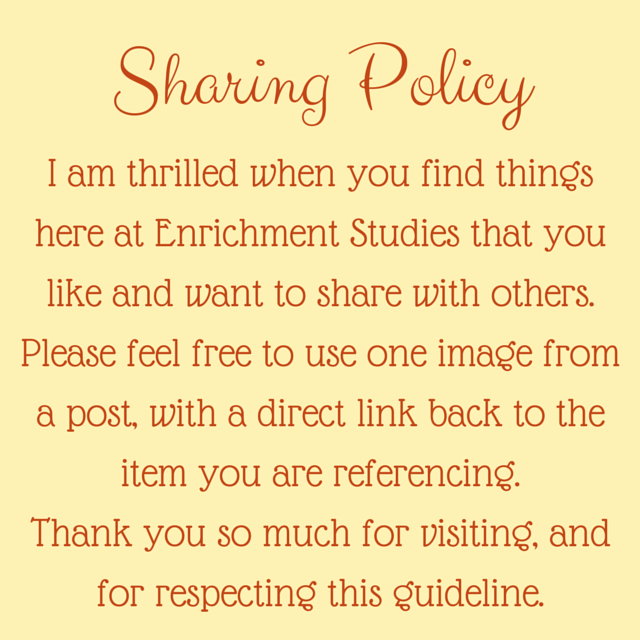by Erica Johns | Mar 6, 2018 | Art, Great Stuff for Homeschool Moms, Spring Fling Giveaways
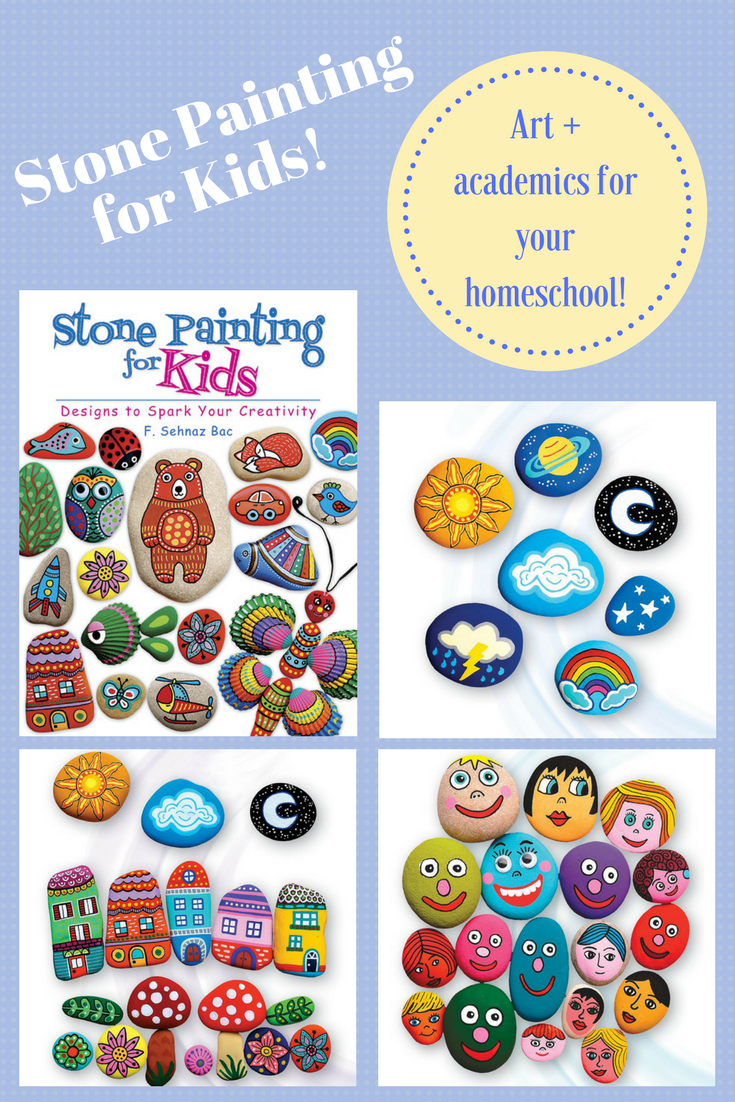
It seems like kids always love arts and crafts, and the new trend of stone painting is super popular and so fun for all ages! What’s more–you can really elevate the crafty side of this activity and use it across all areas of learning! I was incredibly inspired when I got to read through the book Stone Painting for Kids and saw so many possibilities for homeschoolers to mesh the creative with the academic! Read on for lots of creative learning inspiration, sponsored by Dover Publications.
Included in the book are ideas like:
- Geometric shapes (teach your young kids colors and shapes!)
- Numbers (early learning and math opportunities)
- Letters (early reading, spelling, and writing opportunities)
- Hearts
- Faces (including fun cartoon styles that kids will love learning)
- Multi-pebble flowers
- Mushrooms (SO cute!)
- Dominoes (yes! You can make your own dominoes game!)
- Shell painting (fish, butterflies, and more!)
- Chess sets (make your own set and then learn to play!)
- Multi-pebble rabbits and other animals and people
- Words (make sentences, poetry, verses, inspiration pieces, and more!)
- Flowers (combine with your nature studies!)
- Houses and Vehicles (you can make a whole town scene and create vehicles to cruise around!)
- Memory Match game! (perfect for your young kids)
- Sky scenes (including the solar system!)
- Animals of all sorts
- Tic-Tac-Toe game
- Chalkboard paint stones
- Washi taped stones
- Math and counting game ideas
- Storytelling activities
- Spelling games
- Scenes and themes you can make
- and more!
The tons of photos of painted stones and the process to create them are wonderful, and really help you understand the steps you’ll need to take to make something similar yourself. I really like it that stone painting can be as simple as your preschooler would need it to be, but also complex enough to challenge and excite high schoolers and adults.
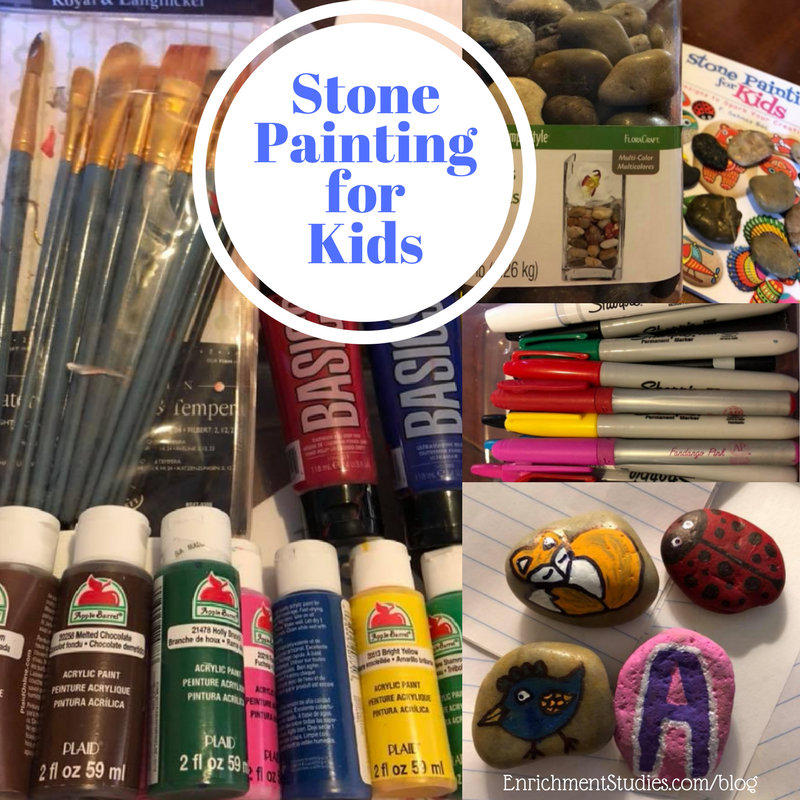 I spent a few enjoyable hours painting stones with the help of this book, and was delighted to see that even someone like me, that doesn’t have great original ideas for thinking something up, could replicate some of these adorable concepts and end up with a fun little treasure to enjoy!
I spent a few enjoyable hours painting stones with the help of this book, and was delighted to see that even someone like me, that doesn’t have great original ideas for thinking something up, could replicate some of these adorable concepts and end up with a fun little treasure to enjoy!
My favorite items that I successfully made were a sleeping fox, a cute birdie, a ladybug, and a pink and purple A to give to my little granddaughter whose name starts with A.
The other thing I super loved about this book is all of the inspiration to enjoy the creative side of this process, but then use the creations in the learning process in your home. Imagine how fun it would be for your kids to paint stones with letters and numbers, and later use those to learn sounds and math! You could work together with your younger children to paint simple stones with just one color per stone, and end up with a wonderful set where you could practice sequencing! For older kids, you could make a solar system set of painted stones, or write out one word per stone from a piece of poetry or Bible verse that you’re memorizing, and enjoy putting them into the right order or creating displays. History lessons can be enhanced by painting stones with homes from different cultures and eras. Nature study can be enjoyed on a rainy or too-cold day by painting stones in ways that remind you of things you’ve seen in your nature walks! Truly, the possibilities are endless, and this book is a wonderful resource for inspiring you and helping you get started.
The author, F. Sehnaz Bac, is a stone paint artist who sells her creations on Etsy, and in this book she takes us by the hand and provides all of the basic advice on how to get started with stone painting, such as choosing stones and preparing them, what materials you can use to paint and decorate them, technique tips, and more. I appreciated that the information in the book was straightforward and to-the-point, and that the step-by-step instructions were helpful without being tedious.
I was pleased to find that art supplies I already had on hand worked great for my stone painting project! The only thing I purchased for this project was a container of craft stones from Walmart for under $5. (They had bags of sea shells available, too!) Other than that, I used the acrylic paints and the paint brushes that I shared about in this post, plus my collection of sharpie markers and a white sharpie paint marker. Easy peasy!
You can connect with Dover Publications at their website, as well as on Facebook, Twitter, and Instagram
Watch my Facebook Live Show & Tell video here:
by Erica Johns | Jan 31, 2018 | Dyslexia, Spring Fling Giveaways
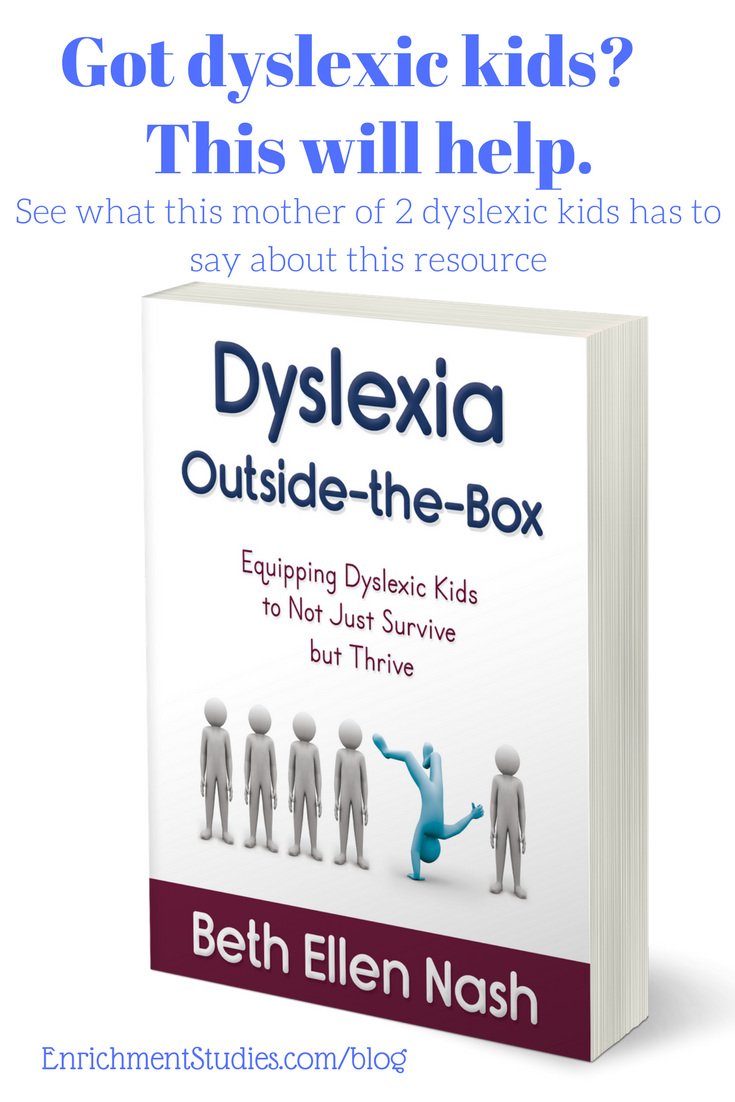 Over the years I’ve shared about my experiences homeschooling my six children, including two of whom have dyslexia. I’m often excited and encouraged to see new developments, awareness, and resources coming available to help other families that are striving to help their children learn, despite any special challenges or difficulties. When I was given the opportunity to review Beth Ellen Nash’s book, Dyslexia Outside-the-Box, I knew I wanted to check it out so I could share about it with other parents that are also searching for answers. The author has kindly sponsored this post, while all opinions expressed are my own.
Over the years I’ve shared about my experiences homeschooling my six children, including two of whom have dyslexia. I’m often excited and encouraged to see new developments, awareness, and resources coming available to help other families that are striving to help their children learn, despite any special challenges or difficulties. When I was given the opportunity to review Beth Ellen Nash’s book, Dyslexia Outside-the-Box, I knew I wanted to check it out so I could share about it with other parents that are also searching for answers. The author has kindly sponsored this post, while all opinions expressed are my own.
Dyslexia can be a really confusing thing for parents to identify and understand, particularly because it’s not a straightforward condition. While many people think that dyslexia is mainly about confusing b and d, p and q, or writing other letters or numbers backwards, instead it includes so many different traits and levels of difficulty, that in some ways I think it would be true to say that it is not exactly the same for any two people. Dyslexia Outside-the-Box offers us a fresh look at both the common challenges that dyslexic people face, but also does the great service of giving us insight into the unique strengths that often accompany dyslexia. This is such an important and encouraging thing for dyslexic kids and parents to understand, because it can be easy to get stuck in a spot where you feel like dyslexia is all about having a learning disability, instead of realizing that it also comes with some superpowers that are pretty awesome. This book does a great job of offering parents and educators information on mitigating the difficulties, while also capitalizing on the strengths that dyslexics are often blessed with. Even my young adult dyslexic son continues to be encouraged by mentions of high-achieving people in all walks of life and throughout history that share his dyslexic traits. These people continue to remind him that while he has some things that are difficult for him, he is also extremely gifted in other areas.
I really appreciated the candor with information about common misperceptions of dyslexics. One of the reasons I knew my dyslexic kids needed to be home educated was because I did not want them in an environment where they were getting the message that they were “the dumb one.” This quote in the book is just one example:
“The brain of the intuitive processor works so quickly that the tongue cannot keep up. Their relatively slower verbal-processing speed leaves observers with the impression they are stupid, daydreaming, not paying attention, or lazy.”
What a valuable insight for parents and educators that may be tempted to jump to these negative conclusions about a child, rather than learning to understand the true nature of what’s going on! Just the other night my 19 year old dyslexic son shared about some of his experiences in a group homeschool class where people were quick to write him off because he was not great at verbalizing his understanding of a topic. When he would have a rare opportunity to express his thoughts, he noticed that the other kids in his class looked kind of amazed that he actually knew something. Well, observant parents usually know that their children are smart, and in the case of dyslexia, a home education can be an ideal space to capitalize on your child’s strengths with no stigma attached. This book is a wonderful resource for all parents with this goal.
The chapters in the book address typical areas of struggle for dyslexics, including reading, spelling, and writing, and give a lot of practical ideas for making learning work in all of these areas. Experienced parents of dyslexic kids may be encouraged to see that some of their favorite learning materials align very well with the recommended ways of approaching these challenges, and for parents that are still figuring out what works, this book is very helpful in giving you insight and guidance on what types of approaches work best for dyslexic kids and why. I really enjoyed seeing the lists of specific ideas related to memory devices, skip counting and other memory songs, role playing and special projects, and more.
 For those of you that have done your fair share of exploration into various methods for addressing dyslexia, you’ll be sure to recognize the many mentioned techniques and approaches such as Orton-Gillingham, Lindamood-Bell, Davis Dyslexia Correction methods, Diane Craft, and others. Author Beth Ellen Nash is quite familiar with all of these, and more, and does a good job of explaining the various ways these can be helpful, and also explains how the services she offers at Wings to Soar Online Academy incorporate a wide range of these skills to help students. There are also lots of mentions of online resources that can be helpful for dyslexics, such as Moby Max, MindPlay, and many others.
For those of you that have done your fair share of exploration into various methods for addressing dyslexia, you’ll be sure to recognize the many mentioned techniques and approaches such as Orton-Gillingham, Lindamood-Bell, Davis Dyslexia Correction methods, Diane Craft, and others. Author Beth Ellen Nash is quite familiar with all of these, and more, and does a good job of explaining the various ways these can be helpful, and also explains how the services she offers at Wings to Soar Online Academy incorporate a wide range of these skills to help students. There are also lots of mentions of online resources that can be helpful for dyslexics, such as Moby Max, MindPlay, and many others.
The appendix section takes up more than half the book and is incredibly valuable. It includes:
- Dyslexia Intervention Options: Excellent advice for parents seeking help within schools, outside of school, and while homeschooling, with specific actionable recommendations that you can start using right away, as well as information that directly pertains to services available through Wings to Soar Online Academy. This section is also very helpful in giving a thorough summary of other popular methods for dyslexia intervention, which will certainly save parents a lot of time and legwork to simply have a good summary in this one resource. I also like that there is specific information about how long it should take before you start to see the fruits of your labors. Knowing what you’re looking for and when to expect to see it is a big help in keeping going with new approaches to help your child!
- Leveling the Playing Field through Accommodations: Whether you’re seeking an IEP in a school setting, or looking for ways to help your child’s learning soar despite their dyslexia, this is a great chapter full of help. Even experienced parents of dyslexics are sure to find at least a few new tools here, or be reminded of a few that you may have forgotten about.
- Teaching Principles, Strategies, and Tools: I love this chapter and the very specific, actionable suggestions for teaching dyslexic kids. This information is pure gold for all home educators with kids of all types, and will provide you with the sort of teacher training that I wish every home educator could receive!
- Expanded Multisensory Practice: This chapter is an additional gem that you will not want to miss!
- High-Frequency Spelling Patterns Worth Learning: I love the practicality and expediency of this approach! This information helps you cut straight to the best use of your time for helping your children (all of them!) learn to spell and understand spelling rules.
- Phonological and Phonemic Awareness Exercises: This chapter is another great teacher training opportunity for parents. So valuable!
- Challenges that Often Co-Exist with Dyslexia: As most parents of dyslexic kids know, it’s usually not just that one thing. Executive function issues, dysgraphia, attention issues, auditory and visual issues, processing issues, and other challenges are often additional factors. This chapter will quickly help you understand what else you might be observing, and give you a starting point for getting help with those things as well.
- Making Sense of Jargon: This is valuable for all parents that are delving into the world of special educational needs. Just like the rest of this book, it’s very practical and useful.
- Resource Recommendations: This terrific section provides you with some of the best and most helpful resources for learning more and solving issues that your kids are facing. For the home educating parent that is typically having to become a junior expert on all of these issues, this section is a great road map for learning and becoming more aware of what’s available to help you and your child.
Overall, this book is very positive, practical, and actionable, and I believe it can be an excellent tool for all parents looking for ways to educate themselves to be able to better help their dyslexic kids. I appreciate that the book has a helpful combination of advice for parents that are interested in becoming equipped to handle these challenges themselves, as well as specific information about how the Wings to Soar Online Academy is available to assist. So many families find expert guidance helpful in situations like this, so it’s great to see yet another practical solution presented so clearly for parents. If you’re interested in learning more about Wings to Soar Online Academy, you can visit their website here, or their facebook page.
by Erica Johns | Jan 29, 2018 | History, Spring Fling Giveaways
Alaska! With the popularity of TV shows like Deadliest Catch, Gold Rush, Alaska The Last Frontier, Life Below Zero, and many others over the past ten years or so, many people have become freshly inspired and amazed by the unique features of this wild and remote land. If your family is one that has caught Alaska fever, you will be delighted to know about a new book series called Aunt Phil’s Trunk.
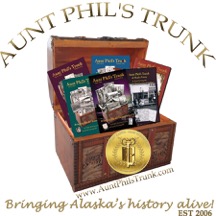 This amazing collection of stories started with the author’s beloved Aunt Phil, who was an award-winning Alaskan history enthusiast. Aunt Phil compiled much research about the history of this great state, and sometimes had stories about that history shared in various newspapers and magazines. Upon her death, she bequeathed her life’s work to her niece, Laurel Downing Bill, who quickly realized what a treasure trove of history she had been entrusted with! Determined to share this information with others, Laurel earned a college degree in journalism and history in order to gain better skills as a storyteller, and set to work compiling these tales, and adding her own additional research to more fully represent Alaska’s story.
This amazing collection of stories started with the author’s beloved Aunt Phil, who was an award-winning Alaskan history enthusiast. Aunt Phil compiled much research about the history of this great state, and sometimes had stories about that history shared in various newspapers and magazines. Upon her death, she bequeathed her life’s work to her niece, Laurel Downing Bill, who quickly realized what a treasure trove of history she had been entrusted with! Determined to share this information with others, Laurel earned a college degree in journalism and history in order to gain better skills as a storyteller, and set to work compiling these tales, and adding her own additional research to more fully represent Alaska’s story.
 The result of many years of relentless curiosity, determination, research, travel, hard work is a whopping five-volume collection of Aunt Phil’s Trunk. Each book covers a separate time period of Alaska’s history. The author was kind enough to send me copies of some of the books and sponsor this post so I could share more about them, and my impressions of it with you.
The result of many years of relentless curiosity, determination, research, travel, hard work is a whopping five-volume collection of Aunt Phil’s Trunk. Each book covers a separate time period of Alaska’s history. The author was kind enough to send me copies of some of the books and sponsor this post so I could share more about them, and my impressions of it with you.
- Volume one covers everything up to 1900, including the Klondike Gold Rush era
- Volume two 1900-1912, includes the birth of many towns, the Iditarod Trail, and first summit of Denali
- Volume three 1912-1935 includes Alaska Railroad, early aviation, and farmers heading north
- Volume four 1935-1960 includes World War II Japanese invasion, the Alaska-Canada Highway, and the battle for Attu
- Volume five 1960-1984 includes early statehood, Good Friday Earthquake, and the trans-Alaska oil pipeline
Each volume is around 330 pages, and they are chock-full of interesting stories, with coordinating historical photos on almost every single two-page spread. The photos really help bring the history alive, and I’m amazed at the amount of research that went into sharing so many fascinating stories! Each chapter shares another intriguing story from Alaska’s history, and would be perfect for reading a bit each day with your children. You will undoubtedly learn about a wide variety of things, and find many jumping-off points that will spark your interests and imagination.
Since we had all five volumes of the book here, I handed out one volume to each of my three high school sons, and my husband and I each had one as well. We enjoyed digging in to read about Alaskan history, and quickly learned so many new things that we had never heard before. From an island that changes size and location (!!) to panning for gold, getting to know more about early explorations and the indigenous Alaskan people and their ways, there are hundreds of intriguing pieces of information included in these books!
As the tales from Aunt Phil’s Trunk gained in popularity, there was a rise in interest from those that wanted to use these books as a curriculum, since this is ideal for the study of Alaskan state study, as well as an additional perspective on American history in general. So they have now developed Student Workbooks and Teacher Guides to accompany each volume as well! The student workbooks are aimed at grades 4-12, and encourage a deep-dive into the study of each volume, with rich, layered activities. These include Discussion Questions and essay opportunities, Enrichment Activity suggestions, reading comprehension questions, map activities, and unit tests, and well as activities like word searches and crossword puzzles.
For families that love to go off the beaten path, follow their curiosities and interests in learning, and find Alaska to be exciting and interesting, Aunt Phil’s Trunk is a uniquely wonderful collection! The author is extending a special offer to Enrichment Studies readers. You can purchase the Gold Nugget Special, which includes Volume 1 of Aunt Phil’s Trunk, along with the student workbook and teacher’s guide for $15 off the already discounted bundle price, PLUS enjoy FREE shipping! Use coupon code HOMESTEADER for your discount! Click here to check out this offer.
by Erica Johns | Jan 3, 2018 | Mom to Mom
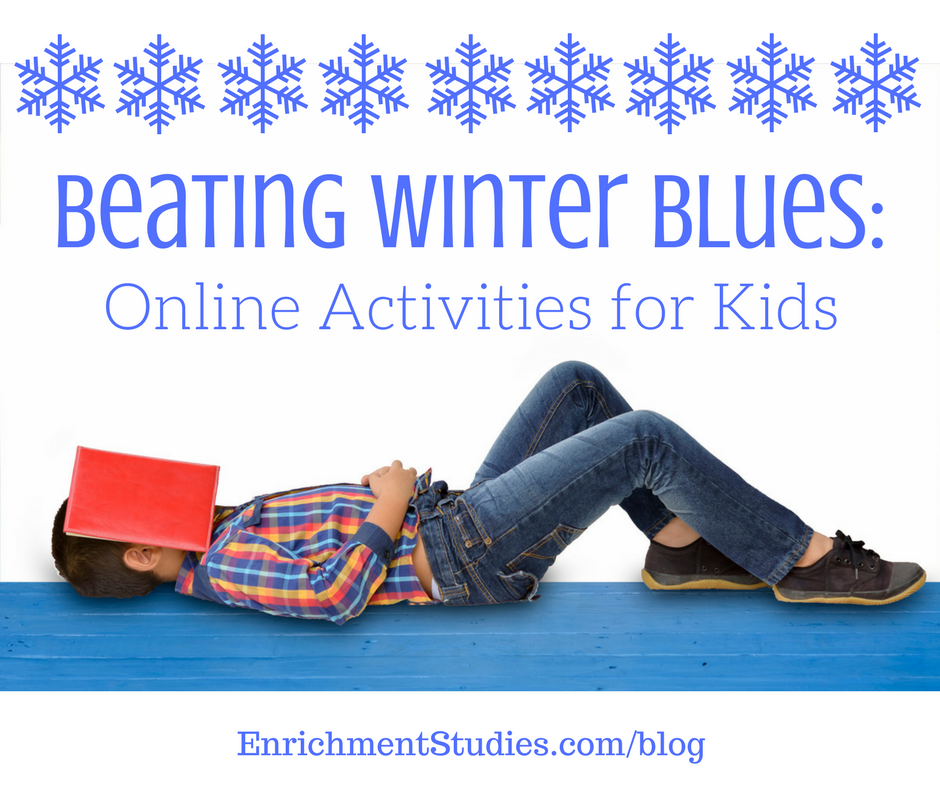 This is a guest post by Jenny Wise from Special Home Educator
This is a guest post by Jenny Wise from Special Home Educator
Oh the weather outside is frightful… and kids don’t find it so delightful!
Having to stay indoors when the winter weather is bad can leave a child feeling restless. Without the freedom to go outside, run, and play, they may turn to binge watching television or playing video games until their hands cramp. However, doing so can be detrimental to their health.
● Kids who watch too much television are more likely to be overweight.
● Television and video games can encourage risky behaviors like drinking or drug use.
● Television and video games can also make children more aggressive.
● Seeing troubling images on television can cause anxiety in kids.
● Spending too much time in front of screens encourages isolationism.
This season, encourage your kids to step away from TV and video games and instead put some time into learning new skills or pursuing their interests online. The internet has various fun and educational online activities perfect for children who are stuck indoors. Here are some of our favorite ideas for you to try.
Exercise Videos
If your child is a bundle of energy that needs to be released, point them to fun, interactive exercise videos specifically made for kids to help! There are tons of options out there, all you need to do is figure out what kind of exercise you child may enjoy.
● Yoga
● Dancing
● Pilates
● Aerobics
● Strength Training
● Rhythmic gymnastics
● Animal crawl exercises
Becoming interested in fitness throughout childhood is extremely important. It helps them create healthy habits that they take with them as they grow. It builds their self-esteem, prevents health issues, and even helps them do better in school.
Online Music Lessons
If your child loves music, now is the perfect time to get them interested in learning to play an instrument. The internet has a vast array of digital music lessons they can reference. At home they are able to pick and choose which songs they learn — if they get to try out their favorite tunes, they are more likely to stick to this new habit! Plus, saving money by taking online lessons makes it easier for you to invest in their instrument. Just be sure to pick one out that is appropriate for beginners. For instance, if they want to learn the saxophone, start out with a beginner’s alto model that they can use to learn the fundamentals. Once they have those down,
they will be better able to pick out which kind of saxophone they want from there (soprano, baritone, tenor, bass).
Drawing Tutorials
If your kid likes to doodle, online drawing tutorials can help them hone their craft. There are plenty of free online art classes for beginners up to the advanced. Arts are extremely important for child development. Some of the benefits include:
● Increased creativity
● More neural connections
● Builds fine motor skills
● Improved problem solving abilities
● Socializing is easier
● Teaches sharing and collaboration
● Taking lessons improves listening and retention skills
● Fosters a better understanding of the world
● Helps young kids learn to write
Staying indoors because of harsh winter weather can make kids feel restless. While their first instinct may be to turn on the television or video games, spending too much time in front of these screens can be detrimental to their well-being. Instead, encourage your children to pick up new skills this season online. Exercise videos release their pent up energy. Learning to play a new instrument is great for kids who love music. And if you child loves to draw, online tutorials can help him refine his talent. Whatever it is your kid loves to do, there is an online class that can help foster that interest.
Jenny Wise created Special Home Educator as a forum for sharing her adventures in homeschooling and connecting with other homeschooling families.
by Erica Johns | Dec 3, 2017 | Great Stuff for Homeschool Moms, History, Inventors, Scientists, Spring Fling Giveaways
History is a tricky thing. On the one hand, we’ve got the well-known, “front burner” historical facts and figures that most of us learn growing up. But then there’s all the less-well-known aspects of history that are just as true, just as valuable, yet often hidden from most people as they learn about all the things that brought us to the place we are today.
When I started Enrichment Studies many years ago, right away I noticed the lack of women and people of color in the arts, and that put me on a path of questioning and discovery. Were there any women or non-white people creating music and art through the ages? I learned that the answer was yes! But why don’t we hear more about them? Why haven’t their contributions earned a spot in the history books? If we only look at the surface, it would be easy to think that so many things have come to us solely through the talents and innovations of white men. Indeed, due to the social structures and conquests of the past, white men have often been in the best position to create and innovate, but they are not the only ones that have. Home educators and involved, mindful parents can reclaim the fullness of history for ourselves and our children by digging deeper and learning more than just the surface level with helpful resources like the ones Tamara Shiloh has created in her Just Imagine….What If There Were No Black People In the World book series. Affiliate links are used in this post.
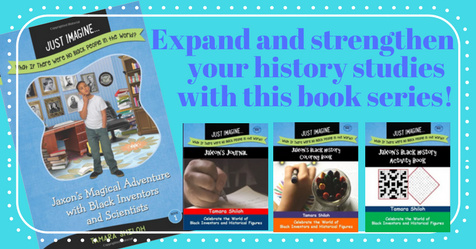 This book caught my attention one day, because the topic matches two we focus on at Enrichment Studies: Inventors and Scientists. I also liked it because this fits in with my desire to help bring about a broader awareness of our diverse history to the homeschool community. I have had the privilege of speaking to Mrs. Shiloh on the phone a few times, and was so excited when she agreed to have me review these books for you. She is also generously sponsoring a giveaway, so be sure to enter at the bottom of this post!
This book caught my attention one day, because the topic matches two we focus on at Enrichment Studies: Inventors and Scientists. I also liked it because this fits in with my desire to help bring about a broader awareness of our diverse history to the homeschool community. I have had the privilege of speaking to Mrs. Shiloh on the phone a few times, and was so excited when she agreed to have me review these books for you. She is also generously sponsoring a giveaway, so be sure to enter at the bottom of this post!
In this sweet story, a young boy named Jaxon is taken on a magical adventure, thanks to his grandmother’s necklace and his curious mind. When he asks himself one day, “What if there were no Black people in the world?” he is taken on a journey of discovery about how his everyday life would be impacted without the many inventions and scientific advancements that were created by the men and women of color that came before him. As I kept learning about these remarkable people, I was filled with gratitude for being able to learn about them, and also filled with a desire to make sure other families get to learn about this too. This isn’t just a book for Black families, although certainly people of color will want to add this delightful book to their collection. But this is a book for every family that truly values history and wants their children to grow up with a broader awareness of our collective human story, and wants to be purposeful in fostering a curious mindset and appreciation for the diversity that is woven into our everyday lives. In the book, one of the inventors says to Jaxon, “We’re your history, and history never goes away.” We have an opportunity to make sure the history and accomplishments of all people is not swept aside and hidden from our awareness, if we are willing to. Change starts at home, and every family has the power to foster greater awareness, compassion, and appreciation for our fellow humans.
In addition to the main storybook, there are three wonderful companion books in the series, so far. Jaxon’s Journal reinforces the information from the main book, while also inspiring kids to create their own journals about things they have learned. Jaxon’s Black History Coloring Book includes the many inventions and scientific advancements from the main book, plus many more. It’s a perfect addition to the book, and provides an activity for younger siblings and students who love to get out their crayons and colored pencils! Jaxon’s Black History Activity Book includes word scrambles, crossword puzzles, word puzzles and games, reading and writing activities about the inventors and scientists, and more. All together this set will provide a lot of fun, historical richness, and reinforcement for your children. It is perfect for a unit study for homeschoolers, or a starting point for research projects. Due to the nice range of materials included in this bundle, I think children from K-high school could certainly appreciate the content, with the elementary and middle school ages probably being most ideal. These books are available at TamaraShiloh.com as well as through Amazon Prime.
 Author Tamara Shiloh is on a mission to educate about Black History year-round, and has many other books in this series coming soon! You can look forward to sharing with your children about Black women that were instrumental in science and inventions, Black cowboys, Black people involved in aviation and astronomy at NASA and beyond, and more.
Author Tamara Shiloh is on a mission to educate about Black History year-round, and has many other books in this series coming soon! You can look forward to sharing with your children about Black women that were instrumental in science and inventions, Black cowboys, Black people involved in aviation and astronomy at NASA and beyond, and more.
 I spent a few enjoyable hours painting stones with the help of this book, and was delighted to see that even someone like me, that doesn’t have great original ideas for thinking something up, could replicate some of these adorable concepts and end up with a fun little treasure to enjoy!
I spent a few enjoyable hours painting stones with the help of this book, and was delighted to see that even someone like me, that doesn’t have great original ideas for thinking something up, could replicate some of these adorable concepts and end up with a fun little treasure to enjoy!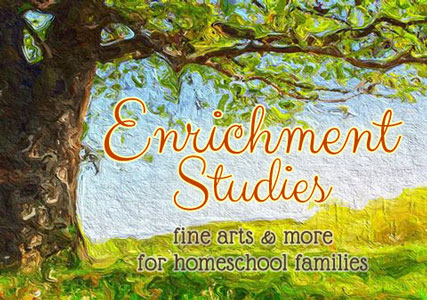






 This is a guest post by Jenny Wise from
This is a guest post by Jenny Wise from 











